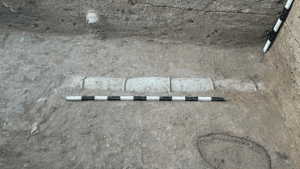TAG: GS 1: ART AND CULTURE
THE CONTEXT: In the ongoing 10th phase of excavations at Keeladi, which commenced on June 18, 2024, archaeologists from the Department of Archaeology have uncovered a significant find—a hollow terracotta pipeline that appears to be part of an ancient drainage system.
EXPLANATION:
- This discovery adds to the growing body of evidence pointing to the advanced technological and architectural skills of the civilization that once thrived in this region.
The Unearthing of Terracotta Pipelines
- The excavated terracotta pipeline consists of six sections aligned together, each measuring 36 cm in length and 18 cm in width.
- When combined, the total length of the unearthed pipeline reaches 174 cm.
- The alignment of these pipes suggests a deliberate and systematic approach to water management or drainage, a hallmark of sophisticated urban planning in ancient societies.

Terracotta pipelines unearthed in the 10th phase of Keeladi excavation in Sivaganga district.
Significance of the Discovery
- Although initial observations suggest that the pipeline may have been part of a drainage system, officials emphasize that further study is required to confirm this hypothesis.
- The discovery of such infrastructure is crucial as it provides insights into the level of engineering and urban planning knowledge possessed by the people who lived in Keeladi.
- The systematic alignment of the pipelines indicates an understanding of the importance of water management, which is essential for sustaining urban settlements.
- This find hints at a well-organized society that prioritized public works and the management of natural resources.
Broader Implications for Keeladi Excavations
- The Keeladi site has been a focal point of archaeological research due to its potential to shed light on the Sangam-era civilization, which is believed to have flourished in South India over 2,000 years ago.
- Discoveries like these terracotta pipelines provide tangible evidence of the technological prowess of this ancient civilization.
- As excavation continues, archaeologists hope to uncover more sections of this pipeline system, which may reveal its full extent and purpose.
- Whether it served as a drainage system, part of a larger water management network, or had another function, the findings will contribute significantly to our understanding of ancient South Indian civilizations.
Keeladi
- Keeladi is an archaeological site located in Tamil Nadu, India near the Vaigai River, approximately 12 km southeast of Madurai.
- The site has gained significant attention due to excavations revealing evidence of a settlement dating back to the Sangam period, specifically between the 6th century BCE and 3rd century CE.
- These findings suggest a well-developed urban civilization in Tamil Nadu during this time, challenging previous historical timelines that placed significant urbanization in the region much later.

